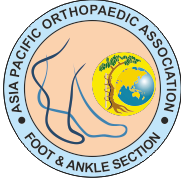Virtual Fellowship 2025
Discuss causes and treatment of Midfoot arthritis
Midfoot arthritis
Table of contents
1. Causes of Midfoot Arthritis [edit]
2. Treatment of Midfoot Arthritis [edit]
Midfoot arthritis, also known as tarsometatarsal arthrosis, is a condition characterized by pain and inflammation in the joints of the middle part of the foot. It occurs when the cartilage that cushions and protects the bones of the midfoot wears down or is damaged.
Here is a discussion of the causes and treatment options for this condition:
Causes of Midfoot Arthritis [edit]
The development of midfoot arthritis is generally due to a few primary factors:
Post-traumatic Arthritis: This is one of the most common causes, where arthritis develops following an injury or trauma to the midfoot. This includes fractures, dislocations, or severe sprains, such as a Lisfranc injury, even if the injury was initially treated.
Osteoarthritis (Degenerative Arthritis): Often referred to as "wear-and-tear" arthritis, it involves the gradual degeneration of cartilage over time. This can be accelerated by:
Aging: Natural wear and tear with age.
Overuse or Long-term Poor Alignment: Chronic repetition of uneven stress on the joints over many years, often exacerbated by the mechanics of the foot.
Obesity/Excess Weight: Putting increased pressure on the foot joints.
Inflammatory Arthritis: Systemic conditions where the body's immune system attacks the joints, leading to inflammation and cartilage damage. Examples include Rheumatoid Arthritis and Psoriatic Arthritis.
Post Hindfoot Fusion: Arthritis that can develop in the midfoot joints following a surgical fusion procedure in the rearfoot, as it transfers stress to the adjacent joints.
Neuropathic (Charcot) Arthritis: Joint destruction secondary to nerve damage, often seen in advanced diabetes.
Treatment of Midfoot Arthritis [edit]
The goal of treatment is to reduce pain, improve mobility, and slow the progression of joint damage. Treatment is typically divided into non-surgical and surgical options.
Non-Surgical Treatment (First-Line Approach)
In many cases, non-surgical methods are effective in managing symptoms.
Medications:
Over-the-Counter (OTC) Pain Relievers: Nonsteroidal Anti-Inflammatory Drugs (NSAIDs) like ibuprofen or naproxen to reduce pain and inflammation.
Corticosteroid Injections: Steroid injections into the affected joint can provide temporary, significant pain and inflammation relief.
Footwear Modifications and Assistive Devices:
Stiff-Soled Shoes: Shoes with a stiff sole, sometimes with a rocker bottom design, can reduce motion in the midfoot joints during walking, thus reducing pain.
Custom Orthotics/Arch Supports: Custom-made shoe inserts can help offload and support the midfoot joints, reduce movement, and correct abnormal foot biomechanics.
Walking Aids: Canes or walkers may be used temporarily to reduce weight-bearing pressure on the foot.
Lifestyle Modifications:
Activity Modification: Limiting or avoiding high-impact activities (like running and jumping) and switching to low-impact exercises (like swimming or cycling).
Weight Management: Losing excess weight significantly reduces stress on the foot joints.
Physical Therapy:
Exercises to improve flexibility, strength, and range of motion, which can help to take pressure off the midfoot joints by strengthening surrounding muscles (e.g., calf muscles).
Surgical Treatment (Reserved for Severe Cases)
Surgery is generally considered when non-surgical treatments fail to provide adequate relief, and the pain significantly impairs daily life.
Arthrodesis (Joint Fusion):
This is the most common surgical procedure for advanced midfoot arthritis.
It involves permanently fusing the arthritic bones of the joint together, eliminating motion and, therefore, the source of pain. The foot may feel stiffer, but the goal is a pain-free, well-aligned foot.
Arthroscopic Debridement:
A minimally invasive procedure to remove inflamed tissue, loose cartilage, or painful bone spurs (osteophytes) in the early stages of arthritis.
Arthroplasty (Joint Replacement):
While more common in other joints, joint replacement in the midfoot is generally not an option due to the minimal movement required and the complex structure.
Partial Joint Denervation:
A minimally invasive procedure to release the nerve sending pain signals to the midfoot. It does not treat the arthritis itself but can eliminate the pain, often considered for older patients who may not be able to tolerate major fusion surgery.

